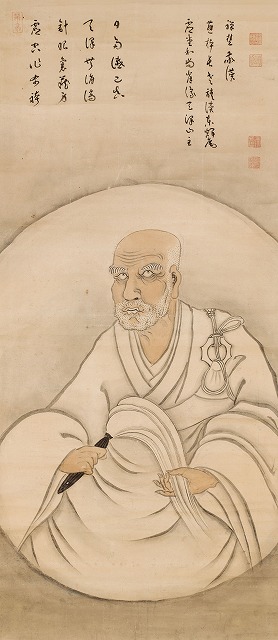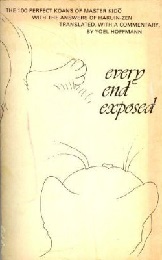ZEN IRODALOM ZEN LITERATURE
« Zen főoldal
« vissza a Terebess Online nyitólapjára
虚堂智愚 Xutang Zhiyu (1185-1269) [aka 息耕 Xigeng*]
(Rōmaji:) Kidō Chigu [aka Sokkō*]

Portrait painting by
Suiō Genro 遂翁元盧 (1717–1789)
*Hakuin's nickname for Xutang. It appears to be unprecedented. As many point out, the name Sokkō seems to have been borrowed from the title of a verse composed by Xutang.
虚堂和尚語錄 Xutang heshang yulu
10 juan. Compiled by Miaoyuan 妙源 (1207-1281)
(Rōmaji:) Kidō oshō goroku (Kidōgoroku)
(English:) The Sayings of Master Xutang
(Magyar:) Hszü-tang hosang jü-lu / Hszü-tang mester mondásai
In: first half of fasc.6. 代別 Daibie (虛堂集 Xutang ji)
(Rōmaji:) Kidō Chigu: Kyodō shū
(English:) Xutang Zhiyu: The Record of Empty Hall
(Magyar:) Hszü-tang csi: Az üres csarnok gyűjteménye
Contents |
Inhaltsverzeichnis |
PDF: The Record of Empty Hall: one hundred classic koans PDF: Every End Exposed 息耕錄開筵普說 Sokkō-roku Kaien-fusetsu
Portrait paintings of 息耕 Sokkō by 白隠慧鶴 Hakuin Ekaku (1686-1769) 虚堂智愚墨 By Xutang Zhiyu. 1 hanging scroll. Ink on paper. 28.5x70.0 Public Cases from the Vacant Hall Collection |
PDF: Kidō oshō goroku (Kidōgoroku). 100 Kōan |
![]()
虚堂智愚 Xutang Zhiyu (1185-1269)
虚堂和尚語錄 Xutang heshang yulu, Compiled by Miaoyuan 妙源 (1207-1281)
6. juan: 代別 Daibie aka 虛堂集 Xutang ji
T47n2000_006 虛堂和尚語錄 第6卷
http://tripitaka.cbeta.org/zh-cn/T47n2000_006
HSÜ-T'ANG HO-SHANG YÜ-LU (Kidō oshō goroku) The Record of Master Hsü-t'ang; also known as the Hsü-t'ang (Kidō roku) The Record of Hsü-t'ang. Compiled by Miao-yüan (Myōgen, n.d.); first printed in 1269, in 10 chüan [T47: 984-1064].
This work comprises the sermons, discourses, comments, verse, and miscellaneous writings of Hsü-t'ang Chih-yü of Ching-shan (Kidō Chigu of Kinzan, 1185-1269), in the 10th generation of the Yang-ch'i (Yōgi) line of Lin-chi (Rinzai) Zen, recorded by his various disciples and compiled by his disciple Miao-yüan. The first seven chüan of the work were published just before Hsü-t'ang died; the remaining three chüan, known as the Hsü-chi (Zokushū), or "Supplement," were published immediately after the Master's death.
A copy of the first seven chüan is said to have been brought to Japan by Hsü-t'ang's Japanese heir, Nampo Jōmyō (1235-1309), better known by his posthumous title Daiō Kokushi. In accordance with a wish expressed by the Kokushi shortly before his death, his disciples published in 1313 a Japanese edition of the complete Kidō roku in 10 kan, adding a short epilogue which includes miscellaneous biographical and other material.
The first half of chüan 6 bears the general title Tai-pieh (Daibetsu). It consists of a collection of one hundred old koans to fifty-three of which are appended answers known as tai-yü (daigo), "offered in place of another," and to the remaining forty-seven of which are appended answers known as pieh-yü (betsugo), "offered as a different opinion." ln the former case a master offers a reply of his own to a mondo which had concluded with the monk engaged in the exchange unable to answer his master's final statement, thus answering "in place of" the original monk. In the latter case, the master, not being in agreement with the final answer to a koan or mondo, offers a different answer conveying his own view… These methods of handling old koans was the first to make collections of one hundred examples of each type of koan and appended answer.
The Tai-pieh (Daibetsu) of Hsü-t'ang Ho-shang (Kidō Oshō) is now used for advanced students of koan study in the Takujū line of Japanese Rinzai Zen. As a separate publication it will be found in the Zudokko, pp. 263-294, under the title Hsü-t'ang lu: tai-pieh (Kidō roku daibetsu).Hsü-t’ang Chih-yü
(1185–1269; Kidô Chigu) A Chinese Rinzai monk of the Sung dynasty (960–1279). Chih-yü was born in a village in what is now Chekiang Province. He took the tonsure at age sixteen at a local temple and then set out on pilgrimage. He practiced under the Rinzai master Yü-an P’u-yen (1156–1226) at Ching-shan in Hangchow, and eventually became his Dharma heir. He was in good favor with the imperial court and held the position of abbot at many of the leading monasteries of his time. After he retired to Hsüeh-tou-shan, the Japanese monk Nampô Jômyô (1235–1309) became his disciple and later carried his Dharma lineage back to Japan.
Hsü-t’ang Lu Tai-pieh
A portion of the Hsü-t’ang Ho-shang Yulu, the Recorded Sayings of Master Hsü-t’ang, which circulates as an independent work, and contains a collection of onehundred old kôan with answers. Fifty-three of the kôan have answers in the tai-yu (J. daigo) style, in which the master responds for the disciple, and the remaining forty-seven have answers of the pieh-yu (J. betsugo) style, in which the master offers an alternative answer to the original. The Hsü-t’ang Lu Taipieh (J. Kidô Roku Daibetsu) is used as an advanced text within the Takujû line of modern Japanese Rinzai.Xutang Zhiyu. (J. Kidō Chigu; K. Hŏdang Chiu 堂智愚) (1185–1269). Chinese
CHAN master in the LINJI ZONG; also known as Xijingsou. Xutang was
ordained at age sixteen by Shiyun (d.u.) of Pumingsi and later became the
disciple of YUN’AN PUYAN (1156–1226). He continued to visit various teachers
throughout the country until he became the abbot of the monastery of
Xingshengsi in 1229. Xutang also served as abbot of many other important Chan
monasteries throughout his illustrious career, including BAOLINSI and
WANSHOUSI. The emperors Lizong (r. 1224–1264) and Duzong (r. 1264–1274)
honored Xutang as their teacher. Among his disciples is the Japanese monk
NANPO JŌMYŌ (1235–1308), to whom the abbots of DAITOKUJI and
MYŌSHINJI trace their lineage. The eminent Japanese monk and abbot of
Daitokuj i, IKKYŪ SŌJUN, even went so far as to consider himself to be a
reincarnation of Xutang and had numerous portraits of himself drawn in the
likeness of Xutang.
Xu tang ji 虛堂集, by Linquan Laoren 林泉老人 (1223–1281)
Linquan Conglun 林泉從倫 (fl. 1268). Linquan laoren pingchang Danxia Chun chanshi songgu Xutang ji 林泉老人評唱丹霞淳禪師頌古虛堂集. In XZJ, vol. 67n1304.X67n1304_006 林泉老人評唱丹霞淳禪師頌古虗堂集 第6卷
http://tripitaka.cbeta.org/X67n1304_006
續藏經 / Xu zang jing
香港影印續藏經委員會 : 發行龍門書店, Hongkong : Xianggang ying yin xu zang jin : Fa xing Long men shu dian, 1967.A pertinent example of this sort of interpretation can be found in the
record of Linquan Laoren 林泉老人 (1223–1281), also known as Linquan
Conglun 林泉從倫, who lived during the late Southern Song and early Yuan
eras. Linquan, a leading disciple of Wansong who is associated with the
Caodong school 曹洞宗, is primarily known as the compiler of Xu tang ji 虛
堂集 (Empty Hall Anthology, complied in 1295) and Kong gu ji 空谷集
(Empty Valley Anthology, preface dated 1285). Kong gu ji, quoted below, is
in six fascicles and features commentaries on a hundred gong’an cases.Xutang ji 虛堂集 (Empty hall anthology), 6 fascicles (x 67: #1304). Full title
Linquan Laoren pingchang Danxia Chun Chanshi songgu xutang ji 林泉老人
評唱丹霞淳禪師頌古虗堂集. The capping phrases and commentaries of the
Caodong master Linquan Conglun 林泉從倫 (n.d.) on a collection of one
hundred koans with verse comments by the Caodong master Danxia Zichun
丹霞子淳 (1064–1117). The work, inspired by collections like the Biyan lu
and the Congrong lu 從容錄 (Record of equanimity) is included in the Sijia
pingchang lu 四家評唱錄 (Commentaries on the Four Houses), a collection
of four koan commentaries.

PDF: Every End Exposed:
The 100 Koans of Master Kidō with the Answers of Hakuin-Zen,
tr. with a commentary by Yoel Hoffmann;
foreword by Hirano Sōjō;
Autumn Press, Brookline, Mass., 1977, 128 p.
A translation of 虚堂和尚語錄 Xutang heshang yulu [Japanese: Kidō oshō goroku / Kidōgoroku] by the Chinese teacher 虚堂智愚 Xutang Zhiyu (1185-1269), Japanese: Kidō Chigu), with comments by the Japanese teacher 白隱慧鶴 Hakuin Ekaku (1686–1769).
[Translation of the final part of Gendai sōjizen hyōron]
The present volume consists primarily of an annotated translation of the Kidōgoroku [The sayings of Master Kidō], a text held in very high regard by Zen practitioners. This ancient Chinese masterpiece, together with the later Japanese responses to it, constitutes the final part of the Gendai Sōjizen Hyōron.
I wish to draw the attention of the reader to the fact that in Master Kidō's comments to these hundred koans, there are also no secrets. These comments were made known to Zen novices and devotees right from the beginning. I think that they are as close as one can possibly come to a "perfect" answer to a koan, and, in my view, the "secret" answers later appended by Hakuin's school of Japanese Zen were, at best, superfluous.
(From the foreword by Zen Master Hirano Sōjō)

Xutang Zhiyu's Dharma Lineage
[...]
菩提達磨 Bodhidharma, Putidamo (Bodaidaruma ?-532/5)
大祖慧可 Dazu Huike (Taiso Eka 487-593)
鑑智僧璨 Jianzhi Sengcan (Kanchi Sōsan ?-606)
大毉道信 Dayi Daoxin (Daii Dōshin 580-651)
大滿弘忍 Daman Hongren (Daiman Kōnin 601-674)
大鑑慧能 Dajian Huineng (Daikan Enō 638-713)
南嶽懷讓 Nanyue Huairang (Nangaku Ejō 677-744)
馬祖道一 Mazu Daoyi (Baso Dōitsu 709-788)
百丈懷海 Baizhang Huaihai (Hyakujō Ekai 750-814)
黃蘗希運 Huangbo Xiyun (Ōbaku Kiun ?-850)
臨濟義玄 Linji Yixuan (Rinzai Gigen ?-866)
興化存獎 Xinghua Cunjiang (Kōke Zonshō 830-888)
南院慧顒 Nanyuan Huiyong (Nan'in Egyō ?-952)
風穴延沼 Fengxue Yanzhao (Fuketsu Enshō 896-973)
首山省念 Shoushan Shengnian (Shuzan Shōnen 926-993)
汾陽善昭 Fenyang Shanzhao (Fun'yo Zenshō 947-1024)
石霜/慈明 楚圓 Shishuang/Ciming Chuyuan (Sekisō/Jimei Soen 986-1039)
楊岐方會 Yangqi Fanghui (Yōgi Hōe 992-1049)
白雲守端 Baiyun Shouduan (Hakuun Shutan 1025-1072)
五祖法演 Wuzu Fayan (Goso Hōen 1024-1104)
圜悟克勤 Yuanwu Keqin (Engo Kokugon 1063-1135)
虎丘紹隆 Huqiu Shaolong (Kukyū Jōryū 1077-1136)
應庵曇華 Yingan Tanhua (Ōan Donge 1103-1163)
密庵咸傑 Mian Xianjie (Mittan Kanketsu 1118-1186)
松源崇岳 Songyuan Chongyue (Shōgen Sūgaku 1132-1202)
運庵普巖 Yunan Puyan (Un'an Fugan 1156–1226)
虛堂智愚 Xutang Zhiyu (Kidō Chigu 1185–1269)